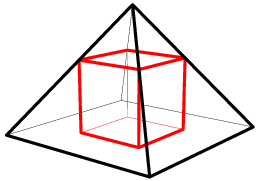Difference between revisions of "2011 AMC 10B Problems/Problem 22"
m (→Problem 22) |
Purplecheese (talk | contribs) (→See Also) |
||
| Line 60: | Line 60: | ||
{{AMC10 box|year=2011|ab=B|num-b=21|num-a=23}} | {{AMC10 box|year=2011|ab=B|num-b=21|num-a=23}} | ||
| + | Umm.... Above, yeah... that's all wrong. The triangle when put in 2d is an equilateral triangle, not a right triangle. and the "rectangle" in 2d should be a square. Sooo yeah don't listen to that. But the answer is right, it is A. Hmm... wonder why :) | ||
Revision as of 16:53, 3 February 2013
Problem
A pyramid has a square base with sides of length ![]() and has lateral faces that are equilateral triangles. A cube is placed within the pyramid so that one face is on the base of the pyramid and its opposite face has all its edges on the lateral faces of the pyramid. What is the volume of this cube?
and has lateral faces that are equilateral triangles. A cube is placed within the pyramid so that one face is on the base of the pyramid and its opposite face has all its edges on the lateral faces of the pyramid. What is the volume of this cube?
![]()
Solution
It is often easier to first draw a diagram for such a problem.
Sometimes, it may also be easier to think of the problem in 2D. Take a cross section of the pyramid through the apex and two points from the base that are opposite to each other. Place it in two dimensions.
![[asy] unitsize(35mm); defaultpen(linewidth(2pt)+fontsize(10pt)); pair A=(0,0), B=(sqrt(2),0), C=(0.5sqrt(2),0.5sqrt(2)); pair W=(sqrt(2)-1,0), X=(1,0), Y=(1,sqrt(2)-1), Z=(sqrt(2)-1,sqrt(2)-1); draw(A--B--C--cycle); draw(W--X--Y--Z--cycle,red); [/asy]](http://latex.artofproblemsolving.com/2/1/5/215607fef86013352901dcb40b988542f35becbf.png)
The dimensions of this triangle are ![]() and
and ![]() because the sidelengths of the pyramid are
because the sidelengths of the pyramid are ![]() and the base of the triangle is the diagonal of the pyramid's base. This is a
and the base of the triangle is the diagonal of the pyramid's base. This is a ![]() triangle. Also, we can let the dimensions of the rectangle be
triangle. Also, we can let the dimensions of the rectangle be ![]() and
and ![]() because the longer side was the diagonal of the cube's base and the shorter cube was a side of the cube.
because the longer side was the diagonal of the cube's base and the shorter cube was a side of the cube.
![[asy] unitsize(35mm); defaultpen(linewidth(2pt)+fontsize(12pt)); pair A=(0,0), B=(sqrt(2),0), C=(0.5sqrt(2),0.5sqrt(2)); pair W=(sqrt(2)-1,0), X=(1,0), Y=(1,sqrt(2)-1), Z=(sqrt(2)-1,sqrt(2)-1); draw(A--B--C--cycle); draw(W--X--Y--Z--cycle,red); label("$1$",(A--C),NW); label("$1$",(B--C),NE); label("$\sqrt{2}$",(A--B),S); label("$s$",(W--Z),E,red); label("$s$",(X--Y),W,red); label("$s\sqrt{2}$",(W--X),N,red); [/asy]](http://latex.artofproblemsolving.com/c/3/6/c360ad03631afaf0bd9850333d36ecfc30161c02.png)
The two triangles on the right and left of the rectangle are also ![]() triangles because the rectangle is perpendicular to the base, and they share a
triangles because the rectangle is perpendicular to the base, and they share a ![]() angle with the larger triangle. Therefore, the legs of the right triangles can be expressed as
angle with the larger triangle. Therefore, the legs of the right triangles can be expressed as ![]()
![[asy] unitsize(35mm); defaultpen(linewidth(2pt)+fontsize(12pt)); pair A=(0,0), B=(sqrt(2),0), C=(0.5sqrt(2),0.5sqrt(2)); pair W=(sqrt(2)-1,0), X=(1,0), Y=(1,sqrt(2)-1), Z=(sqrt(2)-1,sqrt(2)-1); draw(A--B--C--cycle); draw(W--X--Y--Z--cycle,red); label("$1$",(A--C),NW); label("$1$",(B--C),NE); label("$\sqrt{2}$",(A--B),S); label("$s$",(W--Z),E,red); label("$s$",(X--Y),W,red); label("$s\sqrt{2}$",(W--X),N,red); label("$s$",(A--W),N); label("$s$",(X--B),N); [/asy]](http://latex.artofproblemsolving.com/d/0/d/d0dbfd874b642e9b3edf55e50e44d677f4eed432.png)
Now we can just use segment addition to find the value of ![]()
![]()
![]()
The volume of the cube is ![]()
See Also
| 2011 AMC 10B (Problems • Answer Key • Resources) | ||
| Preceded by Problem 21 |
Followed by Problem 23 | |
| 1 • 2 • 3 • 4 • 5 • 6 • 7 • 8 • 9 • 10 • 11 • 12 • 13 • 14 • 15 • 16 • 17 • 18 • 19 • 20 • 21 • 22 • 23 • 24 • 25 | ||
| All AMC 10 Problems and Solutions | ||
Umm.... Above, yeah... that's all wrong. The triangle when put in 2d is an equilateral triangle, not a right triangle. and the "rectangle" in 2d should be a square. Sooo yeah don't listen to that. But the answer is right, it is A. Hmm... wonder why :)










